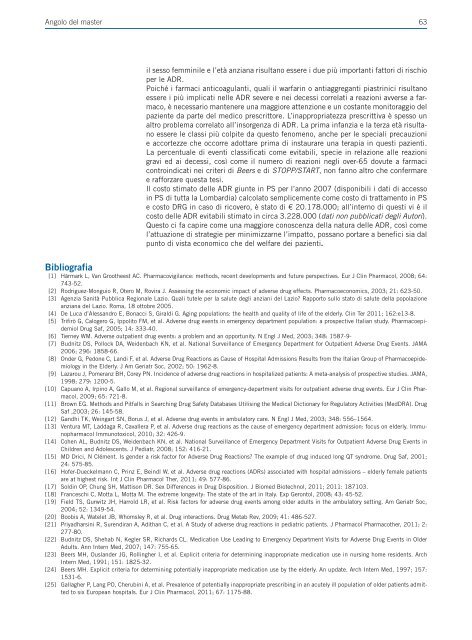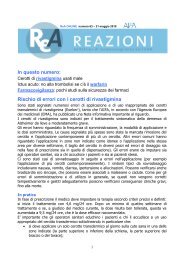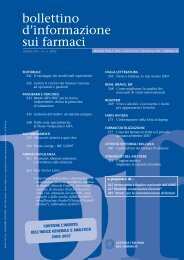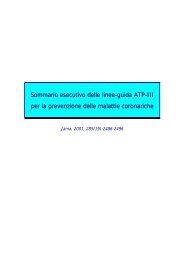Create successful ePaper yourself
Turn your PDF publications into a flip-book with our unique Google optimized e-Paper software.
Angolo del master<br />
il sesso femminile e l’età anziana risultano essere i due più importanti fattori di rischio<br />
per le ADR.<br />
Poiché i farmaci anticoagulanti, quali il warfarin o antiaggreganti piastrinici risultano<br />
essere i più implicati nelle ADR severe e nei decessi correlati a reazioni avverse a farmaco,<br />
è necessario mantenere una maggiore attenzione e un costante monitoraggio del<br />
paziente da parte del medico prescrittore. L’inappropriatezza prescrittiva è spesso un<br />
altro problema correlato all’insorgenza di ADR. La prima infanzia e la terza età risultano<br />
essere le classi più colpite da questo fenomeno, anche per le speciali precauzioni<br />
e accortezze che occorre adottare prima di instaurare una terapia in questi pazienti.<br />
La percentuale di eventi classificati come evitabili, specie in relazione alle reazioni<br />
gravi ed ai decessi, così come il numero di reazioni negli over-65 dovute a farmaci<br />
controindicati nei criteri di Beers e di STOPP/START, non fanno altro che confermare<br />
e rafforzare questa tesi.<br />
Il costo stimato delle ADR giunte in PS per l’anno 2007 (disponibili i dati di accesso<br />
in PS di tutta la Lombardia) calcolato semplicemente come costo di trattamento in PS<br />
e costo DRG in caso di ricovero, è stato di € 20.178.000; all’interno di questi vi è il<br />
costo delle ADR evitabili stimato in circa 3.228.000 (dati non pubblicati degli Autori).<br />
Questo ci fa capire come una maggiore conoscenza della natura delle ADR, così come<br />
l’attuazione di strategie per minimizzarne l’impatto, possano portare a benefici sia dal<br />
punto di vista economico che del welfare dei pazienti.<br />
Bibliografia<br />
[1] Härmark L, Van Grootheest AC. Pharmacovigilance: methods, recent developments and future perspectives. Eur J Clin Pharmacol, 2008; 64:<br />
743-52.<br />
[2] Rodriguez-Monguio R, Otero M, Rovira J. Assessing the economic impact of adverse drug effects. Pharmacoeconomics, 2003; 21: 623-50.<br />
[3] Agenzia Sanità Pubblica Regionale Lazio. Quali tutele per la salute degli anziani del Lazio? Rapporto sullo stato di salute della popolazione<br />
anziana del Lazio. Roma, 18 ottobre 2005.<br />
[4] De Luca d’Alessandro E, Bonacci S, Giraldi G. Aging populations: the health and quality of life of the elderly. Clin Ter 2011; 162:e13-8.<br />
[5] Trifirò G, Calogero G, Ippolito FM, et al. Adverse drug events in emergency department population: a prospective Italian study. Pharmacoepidemiol<br />
Drug Saf, 2005; 14: 333-40.<br />
[6] Tierney WM. Adverse outpatient drug events: a problem and an opportunity. N Engl J Med, 2003; 348: 1587-9-<br />
[7] Budnitz DS, Pollock DA, Weidenbach KN, et al. National Surveillance of Emergency Department for Outpatient Adverse Drug Events. JAMA<br />
2006; 296: 1858-66.<br />
[8] Onder G, Pedone C, Landi F, et al. Adverse Drug Reactions as Cause of Hospital Admissions Results from the Italian Group of Pharmacoepidemiology<br />
in the Elderly. J Am Geriatr Soc, 2002; 50: 1962-8.<br />
[9] Lazarou J, Pomeranz BH, Corey PN. Incidence of adverse drug reactions in hospitalized patients: A meta-analysis of prospective studies. JAMA,<br />
1998; 279: 1200-5.<br />
[10] Capuano A, Irpino A, Gallo M, et al. Regional surveillance of emergency-department visits for outpatient adverse drug events. Eur J Clin Pharmacol,<br />
2009; 65: 721-8.<br />
[11] Brown EG. Methods and Pitfalls in Searching Drug Safety Databases Utilising the Medical Dictionary for Regulatory Activities (MedDRA). Drug<br />
Saf ,2003; 26: 145-58.<br />
[12] Gandhi TK, Weingart SN, Borus J, et al. Adverse drug events in ambulatory care. N Engl J Med, 2003; 348: 556–1564.<br />
[13] Ventura MT, Laddaga R, Cavallera P, et al. Adverse drug reactions as the cause of emergency department admission: focus on elderly. Immunopharmacol<br />
Immunotoxicol, 2010; 32: 426-9.<br />
[14] Cohen AL, Budnitz DS, Weidenbach KN, et al. National Surveillance of Emergency Department Visits for Outpatient Adverse Drug Events in<br />
Children and Adolescents. J Pediatr, 2008; 152: 416-21.<br />
[15] MD Drici, N Clément. Is gender a risk factor for Adverse Drug Reactions? The example of drug induced long QT syndrome. Drug Saf, 2001;<br />
24: 575-85.<br />
[16] Hofer-Dueckelmann C, Prinz E, Beindl W, et al. Adverse drug reactions (ADRs) associated with hospital admissions – elderly female patients<br />
are at highest risk. Int J Clin Pharmacol Ther, 2011; 49: 577-86.<br />
[17] Soldin OP, Chung SH, Mattison DR. Sex Differences in Drug Disposition. J Biomed Biotechnol, 2011; 2011: 187103.<br />
[18] Franceschi C, Motta L, Motta M. The extreme longevity: The state of the art in Italy. Exp Gerontol, 2008; 43: 45-52.<br />
[19] Field TS, Gurwitz JH, Harrold LR, et al. Risk factors for adverse drug events among older adults in the ambulatory setting. Am Geriatr Soc,<br />
2004; 52: 1349-54.<br />
[20] Boobis A, Watelet JB, Whomsley R, et al. Drug interactions. Drug Metab Rev, 2009; 41: 486-527.<br />
[21] Priyadharsini R, Surendiran A, Adithan C, et al. A Study of adverse drug reactions in pediatric patients. J Pharmacol Pharmacother, 2011; 2:<br />
277-80.<br />
[22] Budnitz DS, Shehab N, Kegler SR, Richards CL. Medication Use Leading to Emergency Department Visits for Adverse Drug Events in Older<br />
Adults. Ann Intern Med, 2007; 147: 755-65.<br />
[23] Beers MH, Ouslander JG, Rollingher I, et al. Explicit criteria for determining inappropriate medication use in nursing home residents. Arch<br />
Intern Med, 1991; 151: 1825-32.<br />
[24] Beers MH. Explicit criteria for determining potentially inappropriate medication use by the elderly. An update. Arch Intern Med, 1997; 157:<br />
1531-6.<br />
[25] Gallagher P, Lang PO, Cherubini A, et al. Prevalence of potentially inappropriate prescribing in an acutely ill population of older patients admitted<br />
to six European hospitals. Eur J Clin Pharmacol, 2011; 67: 1175-88.<br />
63






